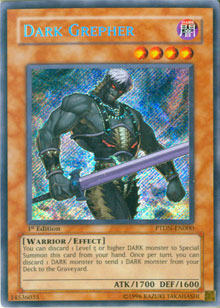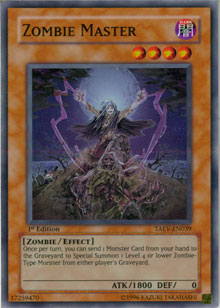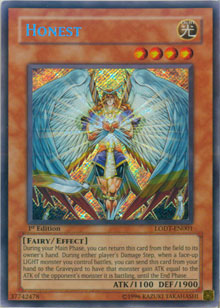There are so many awesome cards coming out lately, from killer new theme support like Mark of the Rose and Secret Village of the Spellcasters to killer new promos like Gorz, Emissary of Darkness, as well as some cool stuff for collectors. It’s a lot to take in, and my brain’s managing everything strictly by dividing the new cards into categories like "legal now" and "not quite legal yet." With those categories firmly in mind, I want to look at one of the best cards in the former column: one that might leave its mark at this weekend’s Shonen Jump Championship in Chicago.
If you haven’t seen it yet, here’s the text of Thunder King Rai-Oh, the promo card from Vol. 2 of the Yu-Gi-Oh! GX manga . . .
Thunder King Rai-Oh
Thunder / Effect
Light / Level 4
1900 ATK / 800 DEF
Neither player can add cards from their Deck to their hand except by drawing them. You can send this face-up card to the Graveyard to negate the Special Summon of 1 of your opponent’s monsters, and destroy it.
The effects of Thunder King Rai-Oh are similar to those seen on a number of cards that came before it. Stopping special summons is nothing new: cards like Vanity's Fiend and Royal Oppression have been doing it for ages, and Thunder King Rai-Oh actually bears a surprising resemblance to Deck Lockdown. The big deal isn’t that Thunder King Rai-Oh does something we’ve never seen before. It’s that it does it far better, with higher utility and greater versatility. Like Vanity's Fiend, Thunder King has the advantage of being a monster instead of a single-purpose spell or trap card, but unlike Vanity's Fiend you can normal summon it without tributing. That brings a powerful theme to all-new heights: Thunder King is splashable, efficient, and can fill a number of roles.
Let’s look at them in-depth.
Stopping Search Effects
Thunder King Rai-Oh actually has two effects, though it’s the summon negation that gets the most press. With that being the general perspective, I want to begin with the other effect instead. The ability to shut down search cards is highly underrated, and gets more powerful with the rise of particular cards released in Crossroads of Chaos.
 Virtually all of the top decks right now rely on search cards for preliminary or intermediary components of their strategy. Teleport Dark Armed Dragon always opens with Elemental Hero Stratos to ensure the early Destiny Hero - Malicious play. Reinforcement of the Army gets Stratos when he doesn’t appear in your opening hand, alternatively fetching Dark Grepher or other Destiny Heroes for Destiny Draw. Sangan nabs tech cards like D.D. Crow and Necro Gardna, or gives quick access to Krebons and Mystic Tomato. Thunder King stops all of those search effects. TeleDAD’s opening moves are devastated by Thunder King’s presence on the field, and it loses access to important combos in the mid-game.
Virtually all of the top decks right now rely on search cards for preliminary or intermediary components of their strategy. Teleport Dark Armed Dragon always opens with Elemental Hero Stratos to ensure the early Destiny Hero - Malicious play. Reinforcement of the Army gets Stratos when he doesn’t appear in your opening hand, alternatively fetching Dark Grepher or other Destiny Heroes for Destiny Draw. Sangan nabs tech cards like D.D. Crow and Necro Gardna, or gives quick access to Krebons and Mystic Tomato. Thunder King stops all of those search effects. TeleDAD’s opening moves are devastated by Thunder King’s presence on the field, and it loses access to important combos in the mid-game.
Lightsworn lose their opening Charge of the Light Brigade, a card that opens up turn 1 plays like Lumina, Lightsworn Summoner into Garoth, Lightsworn Warrior, while loading the graveyard with Plaguespreader Zombie, Wulf, Lightsworn Beast, and Necro Gardna. The deck’s progression toward Judgment Dragon in the mid-game is also slowed, mirroring the two-fisted punch TeleDAD faces.
Even Zombies lose serious steam without the ability to search out cards with Goblin Zombie. The average Zombie deck plans to draw massive numbers of cards with Card of Safe Return, depending on Goblin Zombie to search out the monsters required to loop near-endless Synchro summons with Zombie Master and Plaguespreader Zombie. Pairing Plaguespreader with Goblin Zombie as Synchro material is integral in the early stages of that loop sequence, because the Goblin gets you Zombie Master, Mezuki, and extra monsters to discard for Zombie Master’s effect. Without it, the number of loops you can pull off comes down to how lucky you are at topdecking monsters. Without reliable access to the loop combo you’re left playing a beatdown strategy: something Zombies are very good at, but only if they get a relatively even set of monsters to work with. The loss of search capability means more reliance on luck.
Even Little City takes a hit, losing its ability to search out plenty of Elemental Heroes with Reinforcement of the Army and E - Emergency Call, while also getting cut off from its Elemental Hero Captain Gold into Skyscraper play. Elemental Hero Neos Alius can trade with Thunder King in battle, but only if you draw it first.
Thunder King’s search-stopping effect is actually one of its greatest strengths. Bear that in mind as we move on to the meat of the card’s performance.
Restricting Special Summons
Special summoning wins games: this is no secret, and it seems that the older the Yu-Gi-Oh! TCG gets, the more axiomatic this statement becomes. TeleDAD, Lightsworn, Zombies, and even Gladiator Beasts are all built on a basis of abusive special summoning to accomplish a number of goals: aggressive swarming, mass card drawing, toolboxing—it’s all dependent on special summons, and Thunder King can shut down whichever summon is most important to your opponent’s game position.
 Note that I say "can" and "most important." Unlike similar effects like that of Doomcaliber Knight, Thunder King Rai-Oh’s ability is purely optional: you’ll never get tricked out of your field presence just because your opponent decided to trigger your monster’s effect by throwing a mediocre special summon at it. That makes Thunder King a tactically versatile card that will really test its controller’s skill in complicated game states.
Note that I say "can" and "most important." Unlike similar effects like that of Doomcaliber Knight, Thunder King Rai-Oh’s ability is purely optional: you’ll never get tricked out of your field presence just because your opponent decided to trigger your monster’s effect by throwing a mediocre special summon at it. That makes Thunder King a tactically versatile card that will really test its controller’s skill in complicated game states.
It also means that you can milk Thunder King’s impact for all it’s worth. Barring the rare type of special summon that doesn’t risk card presence (such as Destiny Hero - Malicious’s effect), Thunder King’s ability will almost always permit a card-for-card trade. That means a big opportunity to gain quick card advantage, running over a monster in battle and then making a trade later on to cost your opponent another card. Plays like that are often simple to make thanks to Thunder King’s 1900 ATK, and pulling it off even once can give you strong footing to capitalize on. This format presents plenty of monsters that Thunder King can take down: Stratos, Zombie Master, Kycoo the Ghost Destroyer, Gladiator Beast Laquari, and Garoth, Lightsworn Warrior, just to name a few.
Synchro summons, Dark Armed Dragon, Judgment Dragon, even contact Fusions of Gladiator Beasts . . . there’s no shortage of big moves to stop with Thunder King, and most of them are tremendously more invested than your simple level 4 normal summon. Thunder King’s strength rests in its simplicity, and its potential in both complicated and simplified game states.
So, Where Do You Play It?
That’s a good question, and it has a vast array of suitable answers. The first default pick is obviously Little City: here, Thunder King Rai-Oh instantly slips in over the deck’s previous copies of Garoth. Garoth was only played because he’s an 1850 ATK Light monster—his searchability as a Warrior was a bonus, but he would probably never be searched out with Reinforcement of the Army unless all three copies of Elemental Hero Neos Alius had already been drawn: not a common occurrence. Thunder King isn’t searchable, but it is bigger, and while Garoth was essentially a vanilla beatstick, Thunder King wields two deadly effects. While one does threaten your own search effects, you control how long Thunder King sticks around thanks to its second ability, so it’s all pretty one-sided in practice.
 The attribute shared between Garoth and Thunder King actually dictates the vast majority of the places it’ll see play: that Light attribute means that Thunder King is compatible with Honest, so virtually anything packing Honest can run the card and do nasty things with it. Lightsworn can play it to get an edge over TeleDAD, and it fits the deck’s aggressive pace very well. It’s also a huge gem in Counter Fairies, a deck that desperately needed more beatsticks as well as more negation. The relationship between Thunder King and Counter Fairy’s trap lineup is awesome: on the one hand, those trap cards keep Thunder King on the table. On the other, Thunder King’s ability to tackle big special summoned monsters means that you can reserve traps like Solemn Judgment and Divine Wrath for other threats, giving you more answers across the board. The deck doesn’t usually search cards from the deck either: this is a serious upgrade for Counter Fairies.
The attribute shared between Garoth and Thunder King actually dictates the vast majority of the places it’ll see play: that Light attribute means that Thunder King is compatible with Honest, so virtually anything packing Honest can run the card and do nasty things with it. Lightsworn can play it to get an edge over TeleDAD, and it fits the deck’s aggressive pace very well. It’s also a huge gem in Counter Fairies, a deck that desperately needed more beatsticks as well as more negation. The relationship between Thunder King and Counter Fairy’s trap lineup is awesome: on the one hand, those trap cards keep Thunder King on the table. On the other, Thunder King’s ability to tackle big special summoned monsters means that you can reserve traps like Solemn Judgment and Divine Wrath for other threats, giving you more answers across the board. The deck doesn’t usually search cards from the deck either: this is a serious upgrade for Counter Fairies.
Beyond that, even Gladiator Beasts can run Thunder King, as another deck that does relatively little to-the-hand searching. Gladiator Proving Ground’s effect is certainly nice, but the odds that you’ll have to activate it at the same time you have Thunder King out are pretty slim. Thunder King will usually wind up being tributed in the early game here, slowing down the duel to a pace the Gladiator player can appreciate.
Thunder King’s been overshadowed by other recent releases, but it catapults at least two decks back into the spotlight: Counter Fairies and Little City. If it sees the amount of play it deserves this weekend at Chicago, it seems like a definite pick for Day 2 appearances.
—Jason Grabher-Meyer